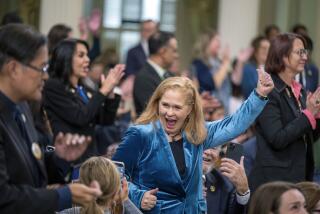State Senate Unit Approves $200 Million in Bills
SACRAMENTO — The Senate Appropriations Committee inaugurated the start of the 1985-86 fiscal year Monday by approving at least $200 million in new spending as it released dozens of bills for floor votes.
The action came as the committee began working its way out from under literally billions of dollars worth of various spending proposals.
Numerous bills were defeated as the committee tackled the logjam of fiscal legislation that had built up pending Gov. George Deukmejian’s signing of the $34.8-billion state budget.
The goal was to keep the number of bills to be voted on by the full Senate roughly within range of the $75 million that Deukmejian has budgeted for legislative spending proposals.
Sen. Alfred E. Alquist (D-San Jose), committee chairman, declared the day’s work a success.
“My goal was to keep the appropriations under $300 million, and I think we did that quite comfortably. But I probably couldn’t get myself elected janitor if it was up to a vote of the rest of the members of the Senate,” Alquist said.
The committee, despite a budget veto of the same program by Deukmejian last Friday, approved a $30-million child care bill by Senate President Pro Tem David A. Roberti (D-Los Angeles) to set up extended day care programs for children of working parents.
It also drew on money expected from oil industry price-fixing cases and next year’s budget revenues in approving a series of major appropriations.
A bill by Sen. Herschel Rosenthal (D-Los Angeles) would allocate $75 million to provide various grants to low-income individuals to subsidize energy bills. The money would come from as much as $150 million that the state will receive as part of a suit by the federal government against oil companies involving overcharges during the 1970s, when gasoline prices were “frozen.”
A bill by Sen. Gary K. Hart (D-Santa Barbara) would take funds from another legal case filed against the oil industry for price-fixing and provide $60 million for a variety of coastal projects, including $30 million to the state Coastal Conservancy.
Other funds would be appropriated for projects aimed at protecting fisheries, developing increased coordination between federal, state and local agencies during oil spills, and creating new research educational projects at the University of California related to marine resources.
Hart and Sen. John Seymour (R-Anaheim) are co-authors of a committee-approved bill that would appropriate $72.6 million for instructional materials at public elementary and high schools. This would be in addition to state aid already going to school districts for the purchase of books, computers and other instructional materials.
Looking ahead to the 1986-87 fiscal year, the committee approved another Hart bill appropriating $60 million in the next state budget for a program designed to reduce class sizes in public schools for 9th through 12th grades.
Fiscal analysts said the bill, aimed at establishing a pupil-teacher ratio of 20 to 1, ultimately could cost the state $500 million to $600 million a year and substantially more than $1 billion annually if the same ratio is extended to elementary schools.
Some Smaller Items
Not all the bills were major spending items. One by Sen. Ed Davis (R-Valencia) would appropriate $175,000 from the state’s general fund, match it with a like amount from the state Fish and Game Preservation Fund and use it to create two four-man teams of fish and game wardens to go after poachers.
The committee, in rejecting other bills, did not kill them outright. They were either held by the committee for later action or amended so that they can be taken up next year.
One of those rejected was a $400-million tax break bill by Sen. William Campbell (R-Hacienda Heights) that would have allowed Californians to deduct contributions to individual retirement accounts from state income tax. The federal government allows deductions of IRA contributions.
More to Read
Get the L.A. Times Politics newsletter
Deeply reported insights into legislation, politics and policy from Sacramento, Washington and beyond. In your inbox three times per week.
You may occasionally receive promotional content from the Los Angeles Times.










